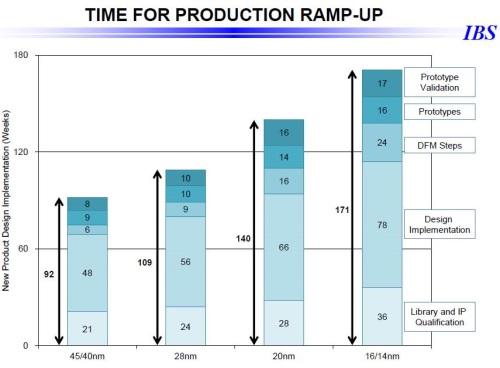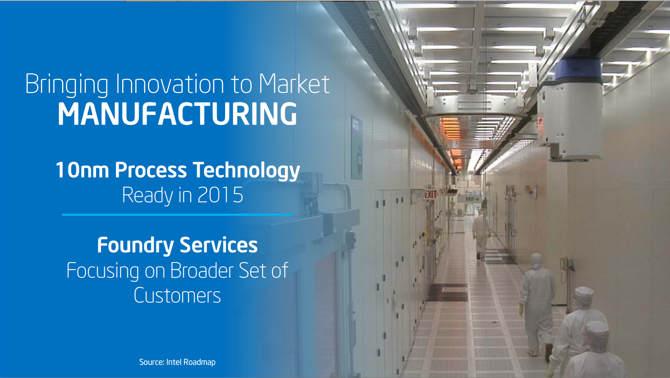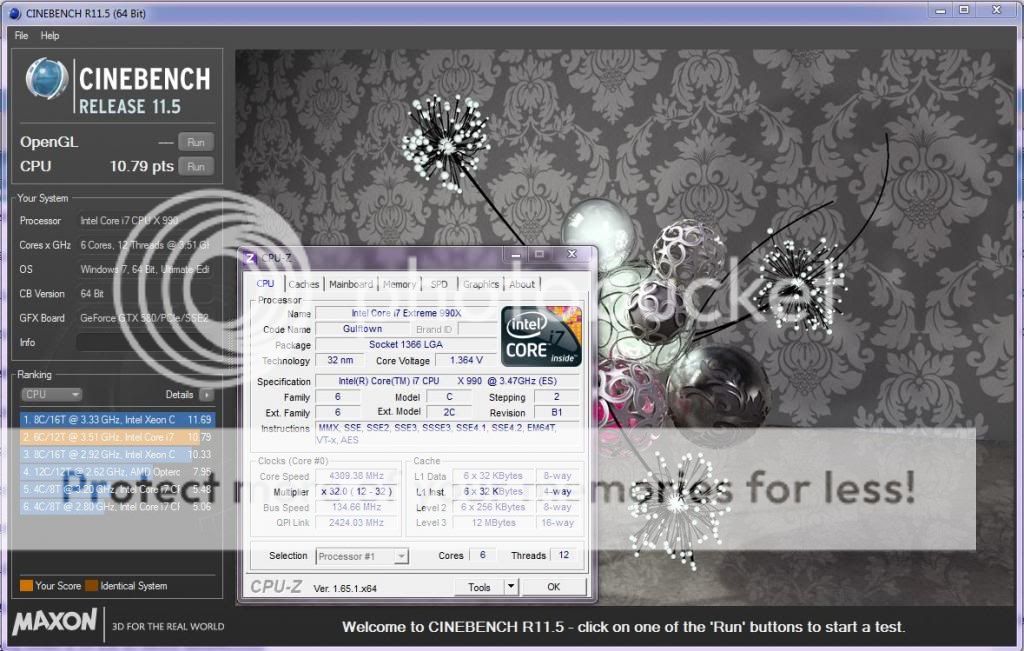- Mar 10, 2006
- 11,715
- 2,012
- 126
Is this for high volume production or testing 10nm production ??
They claimed to have 10nm test chips running in late 2013; the 4Q 2015 production date was supposed to be for high volume, commercial production.
Is this for high volume production or testing 10nm production ??
Bohr was interviewed at IEDM 2014 (Dec. 2014). Intel's last public statement on 10nm was that the plan was to go into production in Q4 2015. Here in Q1 2015, Intel should be close to the finish line if they are indeed going to keep to their original schedule.
That said, Intel expected 14nm to be production viable by Q1 2014, but the process did not qualify for production until Q2 2014. I think this will cause at least a 1 quarter push-out of 10nm with production start in Q1 or Q2 of 2016.
Given that TSMC will go into production on its 10nm in Q4 2016, I would expect Intel to have an ace up their sleeve for this process (crazy tight gate/metal pitches, III-V materials, something...) in order to maintain the "process lead" that it seems so confident that it has.
Now Ill give you a few words on 10 nanometer development update. Our 10 nanometer technology development is progressing and our qualification schedule at the end of 2015 -- end of this year remains the same. We are now working with customers for their product tape outs. We expect this volume production in 2017.
TSMC's last statement was 2017 HVM.
This is still the same schedule as here: http://seekingalpha.com/article/196...semiconductor-have-very-different-definitions
Also, if you say Intel's 10nm will be delayed due to 14nm delay, then you should apply the same logic to TSMC's 10nm, which would then suffer from 16nm's 2-3Q delay.
Also, TSMC 10nm isn't a competitor for Intel's 10nm, but for Intel's 14nm. Both are second gen FinFETs.
--
I found the comment, it was from Holt: http://intelstudios.edgesuite.net/im/2013/archive/qa1/archive.html (23:30)
Roland Shu - Citibank
Just 10 nanometer question to C.C. Since C.C., you said we are expecting to valid [indiscernible] 10 nanometer in 2017. But I remember in the past two quarters actually our goal was up to pull in 10 nanometer [indiscernible] by end of 2015. So [indiscernible] a little bit or not?
C. C. Wei - Co-CEO
Let me explain that because 10 nanometer is the [indiscernible] about 70 to 80. So you got to start in 2016 to have output in 2017. So what I am talking about is 2017 should start to have revenue.
They claimed to have 10nm test chips running in late 2013; the 4Q 2015 production date was supposed to be for high volume, commercial production.
Intel was saying Q4 2015 for 10nm when they were believing 14nm would be Q4 2013. I dont believe they will start HVP before Q4 2016 the earliest.
The excuses... Now the "merits of a process" are totally unrelated to the products produced on it? You guys are bending over backwards mentally to explain the last five years of intel's foundry progress.
You know when I was thinking about the massive leaps in performance ARM is giving (I.e. 100% or often more improvement without even a change in process) I thought about intel's history and for the life of me I can't think of a single generation of Intel chips where the next one (I.e. Haswell to Broadwell i7) gives 100% improvement even once!
Intel has always been a terrible processor company with a decent foundry. The problem is that so much of their business is built on bullying competitors, lying, and outright removing any competition that they never learned to make a decent product.
What they did learn, is how to convince a generation of AT members, supposedly educated individuals, that 2+2=5. Do the math! Find me one generation of processor where Intel can give even just %100 improvement!
I won't ask you to give the 200-500% increases apple often gives.
Cue the rabble of Intel apologists to come explain why all the benchmarks are unfair, Intel is still the fastest and finally they really do have a new faster architecture, they are just unloading this crappy one on those silly customers for margin and will soon release skylake which will blow us all away.
1. My point about the technical merits of a process was only to point out that you can in fact have inferior products on a superior node, because the node is only an enabler for your chip design. It is not the sole and probably not even the most important factor.
2. I think you don't have a good idea about how similar CPUs really are. It's not like AMD or Intel or ARM or Apple has some secret sauce or significantly better engineers that makes their CPU significantly faster than everybody else's. What sets them apart is the tradeoffs they choose to make during the design process and how well those tradeoffs fit their product into market segments. Do you think Apple/ARM or anybody else will keep giving you 100% increases per generation? The answer is clearly no if you have any understanding of how the industry as a whole is progressing. So when you say "Intel is a terrible processor company", I have a hard time understanding your position. They have released the best desktop/server class CPUs for years now. However I would not disagree that they don't have their mobile products positioned low enough on the power scale to compete with ARM and Apple designs. That doesn't mean they're a "terrible processor company", it means they're a processor company who has traditionally focused on frequency targets and has had trouble shifting their focus onto power targets. Although it boggles my mind why Intel is even trying, you don't make 60% margins in mobile.
Regarding the delay...no, I'm not confident that logic applies here. TSMC is on record stating Q4 2016 production for 2017 revenue for 10nm. Intel, which was previously on record for Q4 2015 10nm production, has decided that it doesn't want to tell us much!
We'll see how it all plays out.

Intel was saying Q4 2015 for 10nm when they were believing 14nm would be Q4 2013. I dont believe they will start HVP before Q4 2016 the earliest.

I further expect Skylake to be the "Broadwell" of 2016, with the Skylake-U/H parts taking care of the first 3/4 of 2016 PC demand, and Cannonlake coming in around IDF 2016 timeframe for holiday PC sales.
No, 10nm should come earlier. I expect 12-13 months after Skylake.
12-13 months after Skylake is exactly the timeline I just said
Skylake is holiday '15, Cannonlake will likely be holiday '16.


If you look at my post above, you'll see that Skylake is on track for Computex launch.
There's not so much need for them to rush their flagship line. Their Atom line, though, certainly.No rush? Intel has never been challenged the way they are today. I think they have every reason to rush, and I think they are rushing as fast as they possibly can.
IDC,
I would be very curious as to any insights on why Intel might be quiet about 10nm in light of the quotes witeken posted. Their R&D head is claiming that 10nm won't have the same 14nm yield challenges, their CFO is saying that the startup costs will be on a "normal" cadence, and at the 2013 investor meeting they already said they're aiming for Q4'15 production.
And yet, they don't want to directly answer questions on 10nm right now.
What's your take on this?
the ramp of 14-nm production in Ireland has been pushed out six months to late 2013, attributing the delay to a slowdown in demand rather than technical problems.
I'm personally perplexed because they don't say the same thing to the suppliers. Suppliers are being told they have 10nm yield and timeline issue and that everyone is scrambling in recovery mode.
Citation needed. I haven't heard any credible statements about Intel's 10nm except from Intel.I'm personally perplexed because they don't say the same thing to the suppliers. Suppliers are being told they have 10nm yield and timeline issue and that everyone is scrambling in recovery mode.
We'll see... (but from what I know I consider your post a conspiracy theory)The public statements provide perfect cover for not having to explain that 10nm is shaping up to be an accentuated repeat of 14nm yield-induced delays, but isn't it illegal or something for official statements to be misleading?
Very interesting article, but I think you misinterpreted it: Intel didn't say anything, the whole article is a rumor, so how could they have played it down? And by the way, I'm not sure if Intel was really worrying:I will say this though, when Intel sent 600 Ireland expats packing (sent back to Ireland and cancelled their 14nm training) they made that decision because they already knew (had all the data they needed) that 14nm yields were unacceptably low and that a big delay was in the offing, and yet they played it down publicly and acted as if it was all part of a "smart capex alignment" move owing to unforeseen shifts in market demand.

See above, the article was just a rumor which Intel didn't comment on, and it's unsure whether Intel really thought the lower yield learning was indeed an issue (that would cause more than 1-2 months delay) until June. You can't predict yield learning, as far as I know.You know Intel knew of the 14nm yield issues at the time because you can easily look at their own published 22nm vs 14nm yield graphs and note that the decision was based on the craptastic 14nm yields at that time, not unforeseen market dynamics. They knew the problem was technical and internal but they spun it as being external and unforeseen. These guys are not above withholding materially relevant information when it comes justifying are rationalizing major internal decisions.
I strongly disagree, but we'll seeIs the public just being fed more smokescreen on 10nm? History suggests yes.
I like this take from Russ Fisher:Wait, what? You mean Intel is telling its customers that it is having yield issues with 10nm even though Mark Bohr is on record stating that he doesn't expect such issues at 10nm?
If what you are saying is true, then no wonder they are saying nothing about 10nm status/timelines. This allows them to not make any knowingly false or misleading statements because they aren't making any statements.
At the time of the 2013 investor meeting, things may have been going according to schedule for them to say that they planned to go into production in 4Q 2015.
Now we are ending 2012 and the four 22nm fabs are online. According to Mark Bohr's comments during multiple interviews at the recent Intel Developers Forum, "22nm yields are excellent," "22nm yields are better than we expected," and "22nm yields are the same as 32nm." Bohr is an Intel Technical Fellow and Chief Process Technologist. Bohr, like many technical professionals, is genetically incapable of lying or even fibbing. Now, if Bohr were a marketing guy, his comments might be suspect.
No rush? Intel has never been challenged the way they are today. I think they have every reason to rush, and I think they are rushing as fast as they possibly can.
There's not so much need for them to rush their flagship line. Their Atom line, though, certainly.
Paranoia.challenged by who?
Brian Krzanich might have been excited that he succeeded in his 46M/4X goal for 2014, but really, Intel's plan has always been world domination. Intel, as a computing company, simply cannot afford not to have tablet, IoT and smartphone foothold. You can't do that without having a compelling offer: both in terms of price and features.Again... is intel going to war with samsung or apple like how crucial / micron went to war against samsung and gave us all those delicious SSD prices?
Going to war against another competitor would oversaturate an already saturated market, with very little returns for the company itself.
I dont think intel see's that as any cost benefit or gain, and they most definitely doing want to kill out all competition in every processor market field.
IDC,
I would be very curious as to any insights on why Intel might be quiet about 10nm in light of the quotes witeken posted. Their R&D head is claiming that 10nm won't have the same 14nm yield challenges, their CFO is saying that the startup costs will be on a "normal" cadence, and at the 2013 investor meeting they already said they're aiming for Q4'15 production.
And yet, they don't want to directly answer questions on 10nm right now.
What's your take on this?
Citation needed. I haven't heard any credible statements about Intel's 10nm except from Intel.
I hadn't realized your claims were based on secret information, fair enough.Citation? I think you misunderstood my post, I was responding to Arachnotronic's post which specifically asked me for my "take".
If my "take" was based on a series of citable public domain sources then it wouldn't really be anything "insightful" now would it? Instead it would just be me parroting what a bunch of other people have already said and written elsewhere.
In the same token, my "take" is going to be formed by things I happen to experience first-hand, which may be things that the average forum member might not have the requisite level of education or work experience to correctly decipher, understand, or be privy to in the first place.
If I am to ignore my position and experiences, restricting my conversation to the realm of that which can solely be cited in the public domain then there isn't much point to me being an active forum member, I may as well become a lurker and just read what other people assemble from press releases on the web.
I can't speak to the motivations of high-level individuals at Intel or the reason for them delivering the statements they gave during interviews, but I can tell you there is a bit of a contradiction between what I read in those interviews versus the angst and trepidation that is unavoidable when 10nm is the topic of discussion with certain individuals who make a livelihood by delivering the very thing certain high-level people have gone on record as saying is hunky-dory and peachy-keen.
But Bohr isn't exactly someone from the marketing team, if that's what you meant. He's in fact leading the 7nm effort, and he's also seriously investigating immersion lithography, so 7nm probably isn't planned for 2019 either, and 10nm must fall somewhere in between.Look at the recent Nvidia 970 snafu where you have a PR team that made assumptions about the technical aspects of the product and didn't bring in the technical team to verify. The technical team always knew the reality of the 970 SKU (they created it, after all), and there were a lot of marketing and PR Nvidia people who didn't know, but that didn't keep those Nvidia people from misstating reality and it going uncorrected for months after the fact.
“We felt like we went on a little early with 14nm as far as timing and performance and features and we saw actually competitors adjust to that. So we're gonna be a little bit more prudent, a little smarter about signalling to the industry exactly when, what and where. And you'll have to trust a little bit the 50 year history we have with Moore's Law and that we should be able to keep it going for 51 or 52 years. So we're gonna be a little careful there about that signalling exactly when, what and where.” --Brian Krzanich, CEO Intel, IM’14
Citation needed. I haven't heard any credible statements about Intel's 10nm except from Intel.
“We felt like we went on a little early with 14nm as far as timing and performance and features and we saw actually competitors adjust to that. So we're gonna be a little bit more prudent, a little smarter about signalling to the industry exactly when, what and where.


